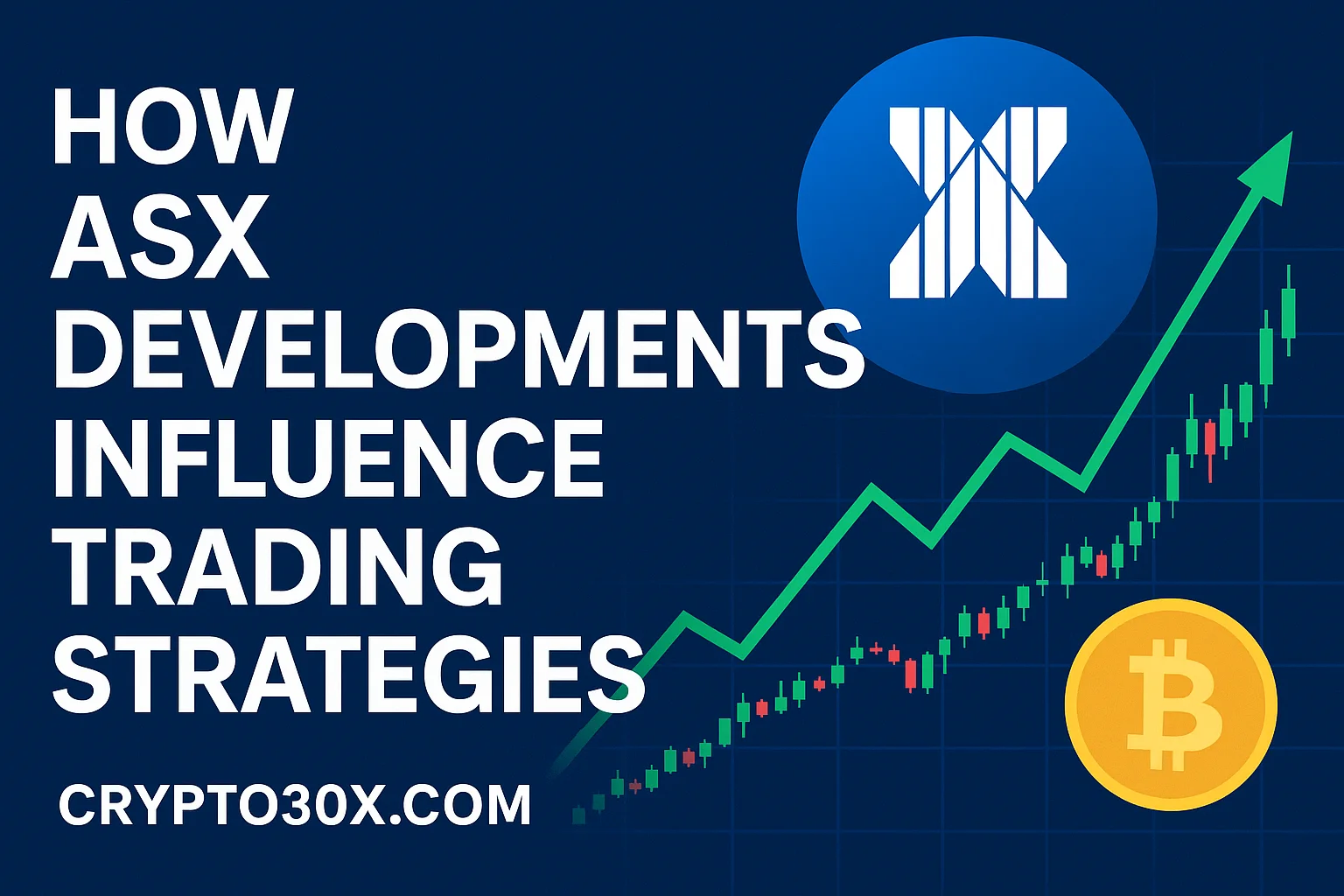The Australian Securities Exchange (ASX) has long been a hub for investors looking to capitalize on market shifts, new listings, and regulatory decisions. However, with the rise of digital assets and global trading platforms such as crypto30x.com, developments on the ASX now play an even greater role in shaping trading strategies for both traditional and crypto traders. This article explores how movements in the ASX impact decision-making, risk management, and portfolio diversification for users of crypto30x.com.
Understanding the Link Between ASX and Crypto Markets
The ASX primarily deals with equities, derivatives, and exchange-traded products, while crypto30x.com focuses on digital currencies and blockchain-based assets. At first glance, these two markets might seem separate. However, investor sentiment, economic indicators, and global financial news often connect them.
- Shared investor psychology: When ASX investors react to interest rate changes or policy updates, the same risk-on or risk-off sentiment tends to spill into crypto markets.
- Capital flow dynamics: Funds moving out of equities during volatile ASX sessions often find their way into alternative assets like cryptocurrencies.
- Regulatory environment: Decisions made by Australian regulators, especially around digital assets, directly affect trading strategies on platforms like crypto30x.com.
See also Crypto30x.com asx – A Complete Guide
Market Trends on the ASX That Influence Crypto Strategies
Interest Rate Announcements
Monetary policy updates from the Reserve Bank of Australia affect investor confidence. When interest rates rise, equities may lose appeal, prompting traders to diversify into crypto assets through platforms like crypto30x.com.
Corporate Earnings and IPOs
New IPOs or strong earnings reports often fuel bullish trends on the ASX. Traders using crypto30x.com monitor these developments closely because capital shifts into equities may reduce liquidity in digital assets, influencing short-term trading strategies.
Global Commodity Prices
Australia’s economy is tied closely to commodities like iron ore and coal. Fluctuations in these markets impact ASX performance and, in turn, guide crypto investors on whether to pursue aggressive trades or adopt hedging strategies.
How Traders Adapt Strategies on crypto30x.com
Diversification Approaches
When ASX markets are uncertain, traders often use crypto30x.com to spread risk across digital currencies. Popular strategies include:
- Pair trading: Balancing exposure by holding both Bitcoin and ASX-related tokenized assets.
- Stablecoin allocations: Using stablecoins to hedge against sudden market downturns.
Short-Term vs Long-Term Positions
- Short-term traders often react quickly to ASX news by adjusting crypto leverage positions, aiming to profit from market swings.
- Long-term investors may use ASX signals to rebalance portfolios, ensuring a mix of equities, commodities, and digital assets.
Risk Management Adjustments
Risk tolerance shifts depending on ASX market conditions. For example, during times of high ASX volatility, traders on crypto30x.com tighten stop-loss orders, reduce leverage, or allocate more to less volatile digital assets.
Impact of ASX Regulatory Developments
Regulatory news from the ASX often sets the tone for how investors view digital assets. For instance:
- New compliance rules may inspire confidence in blockchain-based securities, pushing traders toward digital investments on crypto30x.com.
- Delays in approvals for crypto-linked ETFs or structured products on the ASX may slow institutional adoption, influencing retail traders’ sentiment.
Comparing ASX and crypto30x.com Market Behavior
Trading Hours vs 24/7 Access
The ASX has fixed trading hours, while crypto30x.com operates around the clock. This difference means traders often react to ASX developments after market close by adjusting crypto positions.
Volatility Levels
While ASX equities can be volatile, digital assets generally experience sharper price movements. Traders accustomed to ASX strategies must modify their approach when applying similar methods to crypto markets.
Liquidity Considerations
The ASX is known for deep liquidity in major stocks, whereas crypto30x.com offers both high-liquidity tokens and smaller, emerging projects. This gives traders flexibility but requires sharper risk analysis.
Strategies for Integrating ASX Insights into crypto30x.com Trading
News-Driven Trading
Traders often use breaking ASX news as signals for crypto trading. For example:
- A decline in mining stocks may encourage investment in proof-of-stake cryptocurrencies, perceived as environmentally friendly.
- Strong performance of tech stocks on the ASX may boost confidence in blockchain innovation, driving more trades on crypto30x.com.
Hedging with Cross-Market Assets
ASX developments can trigger hedging strategies:
- Equity downturns → Increase allocation to Bitcoin or Ethereum.
- Commodity rallies → Hedge positions with crypto assets linked to decentralized finance (DeFi) or tokenized commodities.
Long-Term Macro Strategies
Macro traders use ASX trends to shape longer-term crypto strategies. For example, ongoing growth in renewable energy stocks on the ASX may influence crypto30x.com investors to allocate more toward green blockchain projects.
Case Studies: ASX Movements and Crypto Reactions
Example 1: Interest Rate Hikes
When the Reserve Bank of Australia announced an interest rate hike, ASX equities dipped sharply. In response, many traders on crypto30x.com shifted funds into stablecoins, using them as a safe haven until both markets stabilized.
Example 2: Commodity Price Surge
A surge in iron ore prices lifted ASX mining stocks, while traders on crypto30x.com sought to capitalize on the bullish mood by increasing exposure to high-cap tokens, riding the wave of broader risk appetite.
Example 3: IPO Excitement
A major tech IPO on the ASX attracted institutional attention, temporarily pulling liquidity from crypto markets. Active traders on crypto30x.com responded by lowering leverage to avoid being caught in low-volume price swings.
Tools and Features on crypto30x.com That Support ASX-Inspired Strategies
Advanced Charting Tools
Traders can overlay ASX indices and crypto charts to identify correlations.
Risk Management Functions
Features such as stop-loss orders, trailing stops, and customizable leverage help traders adjust based on ASX-driven volatility.
Access to Market News
crypto30x.com integrates global financial news, allowing traders to track ASX updates and adjust strategies instantly.
Challenges in Using ASX Insights for Crypto Trading
While ASX developments can be useful, traders face certain challenges when applying them to crypto markets:
- Lagging correlations: Sometimes ASX and crypto markets react at different speeds.
- Overreliance on macro signals: Crypto often moves independently of equities, driven by blockchain-specific news.
- Global influences: U.S. and European markets may override ASX impacts on crypto sentiment.
Best Practices for Traders
To effectively use ASX insights on crypto30x.com, traders should:
- Combine ASX analysis with global crypto fundamentals.
- Avoid chasing short-term moves without proper risk controls.
- Use a balanced portfolio strategy, spreading investments across asset classes.
Future Outlook: ASX-Crypto Interactions
Looking ahead, the connection between ASX developments and crypto trading strategies is likely to grow stronger. The potential launch of blockchain-based securities on the ASX and the increasing institutional adoption of digital assets may create even deeper ties between the two markets. Platforms like crypto30x.com are well-positioned to support traders as they navigate this evolving landscape.
Conclusion
The relationship between ASX developments and trading strategies on crypto30x.com highlights the growing convergence of traditional and digital markets. From interest rate changes to commodity price movements, ASX signals often serve as valuable indicators for crypto traders. By carefully monitoring these developments and using the tools available on crypto30x.com, traders can craft strategies that balance risk, capture opportunities, and adapt to the fast-changing dynamics of global finance.


